Fifty Years of Tidewater Glacier Surface Elevation and Retreat Dynamics along the South-East Coast of Spitsbergen (Svalbard Archipelago)
Abstract
:1. Introduction
2. Material and Methods
2.1. Study Site
2.2. Detection of Surface Elevation Changes
2.3. Glacier Front Positions
3. Results
3.1. Glacier Retreat
3.2. Surface Elevation Changes
3.3. Zero Surface Elevation Change Altitude
3.4. Glacier Geometry
4. Discussion
5. Conclusions
Supplementary Materials
Author Contributions
Funding
Data Availability Statement
Acknowledgments
Conflicts of Interest
References
- Nuth, C.; Kohler, J.; König, M.; von Deschwanden, A.; Hagen, J.O.; Kääb, A.; Moholdt, G.; Pettersson, R. Decadal changes from a multi-temporal glacier inventory of Svalbard. Cryosphere 2013, 7, 1603–1621. [Google Scholar] [CrossRef] [Green Version]
- Rotschky, G.; Schuler, T.V.; Haarpaintner, J.; Kohler, J.; Isaksson, E. Spatio-temporal variability of snowmelt across Svalbard during the period 2000–2008 derived from QuikSCAT/SeaWinds scatterometry. Polar Res. 2011, 30, 5963. [Google Scholar] [CrossRef]
- Lydersen, C.; Assmy, P.; Falk-Petersen, S.; Kohler, J.; Kovacs, K.M.; Reigstad, M.; Steen, H.; Strøm, H.; Sundfjord, A.; Varpe, Ø.; et al. The importance of tidewater glaciers for marine mammals and seabirds in Svalbard, Norway. J. Mar. Syst. 2014, 129, 452–471. [Google Scholar] [CrossRef]
- Hopwood, M.J.; Carroll, D.; Browning, T.J.; Meire, L.; Mortensen, J.; Krisch, S.; Achterberg, E.P. Non-linear response of summertime marine productivity to increased meltwater discharge around Greenland. Nat. Commun. 2018, 9, 3256. [Google Scholar] [CrossRef] [PubMed]
- Vonnahme, T.R.; Persson, E.; Dietrich, U.; Hejdukova, E.; Dybwad, C.; Elster, J.; Chierici, M.; Gradinger, R. Early spring subglacial discharge plumes fuel under-ice primary production at a Svalbard tidewater glacier. Cryosphere 2021, 15, 2083–2107. [Google Scholar] [CrossRef]
- Blaszczyk, M.; Jania, J.A.; Hagen, J.O. Tidewater glaciers of Svalbard: Recent changes and estimates of calv-ing fluxes. Pol Polar Res. 2009, 30, 85–142. [Google Scholar]
- Hagen, J.O.; Kohler, J.; Melvold, K.; Winther, J.-G. Glaciers in Svalbard: Mass balance, runoff and freshwater flux. Polar Res. 2003, 22, 145–159. [Google Scholar] [CrossRef] [Green Version]
- Martín-Moreno, R.; Álvarez, F.A.; Hagen, J.O. ‘Little Ice Age’ glacier extent and subsequent retreat in Svalbard archipelago. Holocene 2017, 27, 1379–1390. [Google Scholar] [CrossRef]
- Luckman, A.; Benn, D.; Cottier, F.; Bevan, S.; Nilsen, F.; Inall, M. Calving rates at tidewater glaciers vary strongly with ocean temperature. Nat. Commun. 2015, 6, 8566. [Google Scholar] [CrossRef] [PubMed] [Green Version]
- Schuler, T.V.; Kohler, J.; Elagina, N.; Hagen, J.O.M.; Hodson, A.J.; Jania, J.A.; Kääb, A.M.; Luks, B.; Małecki, J.; Moholdt, G.; et al. Reconciling Svalbard Glacier Mass Balance. Front. Earth Sci. 2020, 8, 156. [Google Scholar] [CrossRef]
- Nuth, C.; Moholdt, G.; Kohler, J.; Hagen, J.O.; Kääb, A. Svalbard glacier elevation changes and contribution to sea level rise. J. Geophys. Res. 2010, 115, F01008. [Google Scholar] [CrossRef] [Green Version]
- Möller, M.; Kohler, J. Differing Climatic Mass Balance Evolution Across Svalbard Glacier Regions Over 1900–2010. Front. Earth Sci. 2018, 6, 128. [Google Scholar] [CrossRef] [Green Version]
- Lefauconnier, B.; Hagen, J.O. Surging and calving glaciers in eastern Svalbard. Nor. Polarinst. Medd. 1991, 116, 130. [Google Scholar]
- Ziaja, W.; Maciejowski, W.; Ostafin, K. Northeastern Sørkappland Landscape Dynamics (Spitsbergen, Svalbard); Jagiellonian University Press: Krakow, Poland, 2007; ISBN 978-83-233-2317-4. [Google Scholar]
- Ziaja, W.; Ostafin, K. Landscape–Seascape dynamics in the isthmus between Sørkapp Land and the rest of Spitsbergen: Will a new big Arctic island form? Ambio 2015, 44, 332–342. [Google Scholar] [CrossRef] [PubMed] [Green Version]
- Cygankiewicz-Truś, A.; Ziaja, W. From Glaciated Landscape to Unglaciated Seascape: Transformation of the Hambergbreen–Hambergbukta Area, SE Spitsbergen, 1900–2017. Ann. Am. Assoc. Geogr. 2021, 111, 1949–1966. [Google Scholar] [CrossRef]
- Hanssen-Bauer, I.; Førland, E.J.; Hisdal, H.; Mayer, S.; Sandø, A.B.; Sorteberg, A. Climate in Svalbard 2100—A Knowledge Base for Climate Adaptation; Norwegian Centre for Climate Services (NCCS) for Norwegian Environment Agency: Trondheim, Norway, 2019. [Google Scholar]
- Moholdt, G.; Nuth, C.; Hagen, J.O.; Kohler, J. Recent elevation changes of Svalbard glaciers derived from ICESat laser altimetry. Remote Sens. Environ. 2010, 114, 2756–2767. [Google Scholar] [CrossRef]
- Błaszczyk, M.; Ignatiuk, D.; Grabiec, M.; Kolondra, L.; Laska, M.; Decaux, L.; Jania, J.; Berthier, E.; Luks, B.; Barzycka, B.; et al. Quality Assessment and Glaciological Applications of Digital Elevation Models Derived from Space-Borne and Aerial Images over Two Tidewater Glaciers of Southern Spitsbergen. Remote Sens. 2019, 11, 1121. [Google Scholar] [CrossRef] [Green Version]
- Rastner, P.; Prinz, R.; Notarnicola, C.; Nicholson, L.; Sailer, R.; Schwaizer, G.; Paul, F. On the Automated Mapping of Snow Cover on Glaciers and Calculation of Snow Line Altitudes from Multi-Temporal Landsat Data. Remote Sens. 2019, 11, 1410. [Google Scholar] [CrossRef] [Green Version]
- Kavan, J.; Haagmans, V. Seasonal dynamics of snow ablation on selected glaciers in central Spitsbergen derived from Sentinel-2 satellite images. J. Glaciol. 2021, 67, 961–966. [Google Scholar] [CrossRef]
- Schellenberger, T.; Van Wychen, W.; Copland, L.; Kääb, A.; Gray, L. An Inter-Comparison of Techniques for Determining Velocities of Maritime Arctic Glaciers, Svalbard, Using Radarsat-2 Wide Fine Mode Data. Remote Sens. 2016, 8, 785. [Google Scholar] [CrossRef] [Green Version]
- Małecki, J. Elevation and volume changes of seven Dickson Land glaciers, Svalbard, 1960–1990–2009. Polar Res. 2013, 32, 18400. [Google Scholar] [CrossRef]
- Ziaja, W.; Dudek, J.; Ostafin, K. Landscape transformation under the Gåsbreen glacier recession since 1899, southwestern Spitsbergen. Pol. Polar Res. 2016, 37, 155–172. [Google Scholar] [CrossRef] [Green Version]
- Wójcik, K.A.; Sobota, I. Spatial and temporal changes in ablation, distribution and evolution of glacial zones on Irenebreen, a small glacier of the High Arctic, Svalbard. Polar Sci. 2020, 23, 100503. [Google Scholar] [CrossRef]
- Østby, T.I.; Schuler, T.V.; Hagen, J.O.; Hock, R.; Kohler, J.; Reijmer, C.H. Diagnosing the decline in climatic mass balance of glaciers in Svalbard over 1957–2014. Cryosphere 2017, 11, 191–215. [Google Scholar] [CrossRef] [Green Version]
- van Pelt, W.J.J.; Schuler, T.V.; Pohjola, V.A.; Pettersson, R. Accelerating future mass loss of Svalbard glaciers from a multi-model ensemble. J. Glaciol. 2021, 67, 485–499. [Google Scholar] [CrossRef]
- Hagen, J.O.; Liestøl, O.; Roland, E.; Jørgensen, T. Glacier Atlas of Svalbard and Jan Mayen. Nor. Pola-Rinstitutt Medd. 1993, 129, 144. [Google Scholar]
- Maciejowski, W.; Michniewski, A. Variations in weather on the East and West coasts of South Spitsber-gen, Svalbard. Pol. Polar Res. 2007, 28, 123–136. [Google Scholar]
- Sulikowska, A.; Wypych, A.; Mitka, K.; Maciejowski, W.; Ostafin, K.; Ziaja, W. Summer weather condi-tions in 2005 and 2016 on the western and eastern coasts of south Spitsbergen. Pol. Polar Res. 2018, 39, 127–144. [Google Scholar] [CrossRef]
- Szymański, W.; Maciejowski, W.; Ostafin, K.; Ziaja, W.; Sobucki, M. Impact of parent material, vegetation cover, and site wetness on variability of soil properties in proglacial areas of small glaciers along the northeastern coast of Sørkappland (SE Spitsbergen). Catena 2019, 183, 104209. [Google Scholar] [CrossRef]
- Nordli, Ø.; Przybylak, R.; Ogilvie, A.E.; Isaksen, K. Long-term temperature trends and variability on Spitsbergen: The extended Svalbard Airport temperature series, 1898–2012. Polar Res. 2014, 33, 21349. [Google Scholar] [CrossRef] [Green Version]
- Nordli, Ø.; Wyszyński, P.; Gjelten, H.M.; Isaksen, K.; Łupikasza, E.; Niedźwiedź, T.; Przybylak, R. Revisiting the extended Svalbard Airport monthly temperature series, and the compiled corresponding daily series 1898–2018. Polar Res. 2020, 39, 3614. [Google Scholar] [CrossRef]
- Sinnhuber, B.-M. Historic temperature observations on Nordaustlandet, north-east Svalbard. Polar Res. 2021, 40, 7564. [Google Scholar] [CrossRef]
- Sund, M.; Eiken, T.; Hagen, J.O.; Kääb, A. Svalbard surge dynamics derived from geometric changes. Ann. Glaciol. 2009, 50, 50–60. [Google Scholar] [CrossRef] [Green Version]
- Sund, M.; Błaszczyk, M.; Eiken, T.; Jania, J.A. The Implications of Surge and Tidewater Glacier Dynamics Related to Climate Change Response of Svalbard Glaciers. Ph.D. Thesis, Universitet i Oslo, Oslo, Norway, 2011. [Google Scholar]
- Flink, A.E.; Noormets, R.; Kirchner, N.; Benn, D.I.; Luckman, A.; Lovell, H. The evolution of a submarine landform record following recent and multiple surges of Tunabreen glacier, Svalbard. Quat. Sci. Rev. 2015, 108, 37–50. [Google Scholar] [CrossRef] [Green Version]
- Sevestre, H.; Benn, D.I. Climatic and geometric controls on the global distribution of surge-type glaciers: Implications for a unifying model of surging. J. Glaciol. 2015, 61, 646–662. [Google Scholar] [CrossRef] [Green Version]
- Lovell, H.; Fleming, E.J.; Benn, D.I.; Hubbard, B.; Lukas, S.; Rea, B.R.; Noormets, R.; Flink, A.E. Debris entrainment and landform genesis during tidewater glacier surges. J. Geophys. Res. Earth Surf. 2015, 120, 1574–1595. [Google Scholar] [CrossRef] [Green Version]
- Farnsworth, W.R.; Ingólfsson, Ó.; Retelle, M.; Schomacker, A. Over 400 previously undocumented Svalbard surge-type glaciers identified. Geomorphology 2016, 264, 52–60. [Google Scholar] [CrossRef]
- Noormets, R.; Flink, A.; Kirchner, N. Glacial dynamics and deglaciation history of Hambergbukta reconstructed from submarine landforms and sediment cores, SE Spitsbergen, Svalbard. Boreas 2021, 50, 29–50. [Google Scholar] [CrossRef]
- Porter, C.; Morin, P.; Howat, I.; Noh, M.-J.; Bates, B.; Peterman, K.; Keesey, S.; Schlenk, M.; Gardiner, J.; Tomko, K.; et al. ArcticDEM. Earth Environ. Sci. 2018. Available online: https://www.pgc.umn.edu/data/arcticdem/ (accessed on 11 May 2021). [CrossRef]
- Pälli, A.; Moore, J.C.; Jania, J.; Glowacki, P. Glacier changes in southern Spitsbergen, Svalbard, 1901–2000. Ann. Glaciol. 2003, 37, 219–225. [Google Scholar] [CrossRef] [Green Version]
- Błaszczyk, M.; Jania, J.A.; Kolondra, L. Fluctuations of tidewater glaciers in Hornsund Fjord (Southern Svalbard) since the beginning of the 20th century. Pol. Polar Res. 2013, 34, 327–352. [Google Scholar] [CrossRef]
- Strzelecki, M.C.; Szczuciński, W.; Dominiczak, A.; Zagórski, P.; Dudek, J.; Knight, J. New fjords, new coasts, new landscapes: The geomorphology of paraglacial coasts formed after recent glacier retreat in Brepollen (Hornsund, southern Svalbard). Earth Surf. Process Landf. 2020, 45, 1325–1334. [Google Scholar] [CrossRef] [Green Version]
- Grabiec, M.; Ignatiuk, D.; Jania, J.A.; Moskalik, M.; Głowacki, P.; Błaszczyk, M.; Budzik, T.; Walczowski, W. Coast formation in an Arctic area due to glacier surge and retreat: The Hornbreen-Hambergbreen case from Spistbergen. Earth Surf. Process Landf. 2017, 43, 387–400. [Google Scholar] [CrossRef]
- Kavan, J. Early twentieth century evolution of Ferdinand glacier, Svalbard, based on historic photographs and structure-from-motion technique. Geogr. Ann. 2020, 102, 57–67. [Google Scholar] [CrossRef]
- Førland, E.J.; Benestad, R.E.; Hanssen-Bauer, I.; Haugen, J.E.; Skaugen, T.E. Temperature and Precipitation Development at Svalbard 1900–2100. Adv. Meteorol. 2011, 2011, 893790. [Google Scholar] [CrossRef]
- Laska, M.; Barzycka, B.; Luks, B. Melting Characteristics of Snow Cover on Tidewater Glaciers in Hornsund Fjord, Svalbard. Water 2017, 9, 804. [Google Scholar] [CrossRef]
- Małecki, J. Snow accumulation on a small high-arctic glacier svenbreen: Variability and topographic controls. Geogr. Ann. 2015, 97, 809–817. [Google Scholar] [CrossRef]
- Asbjørnsen, H.; Årthun, M.; Skagseth, Ø.; Eldevik, T. Mechanisms Underlying Recent Arctic Atlantification. Geophys. Res. Lett. 2020, 47, e2020GL088036. [Google Scholar] [CrossRef]
- Marlin, C.; Tolle, F.; Griselin, M.; Bernard, E.; Saintenoy, A.; Quenet, M.; Friedt, J.-M. Change in geometry of a high Arctic glacier from 1948 to 2013 (Austre Lovénbreen, Svalbard). Geogr. Ann. 2017, 99, 115–138. [Google Scholar] [CrossRef]
- Noël, B.; Jakobs, C.L.; Van Pelt, W.J.J.; Lhermitte, S.; Wouters, B.; Kohler, J.; Hagen, J.O.; Luks, B.; Reijmer, C.H.; Van De Berg, W.J.; et al. Low elevation of Svalbard glaciers drives high mass loss variability. Nat. Commun. 2020, 11, 4597. [Google Scholar] [CrossRef]
- Strozzi, T.; Kääb, A.; Schellenberger, T. Frontal destabilization of Stonebreen, Edgeøya, Svalbard. Cryosphere 2017, 11, 553–566. [Google Scholar] [CrossRef] [Green Version]
- Murray, T.; Stuart, G.W.; Miller, P.J.; Woodward, J.; Smith, A.M.; Porter, P.R.; Jiskoot, H. Glacier surge propagation by thermal evolution at the bed. J. Geophys. Res. 2000, 105, 13491–13507. [Google Scholar] [CrossRef] [Green Version]
- Sevestre, H.; Benn, D.I.; Luckman, A.; Nuth, C.; Kohler, J.; Lindbäck, K.; Pettersson, R. Tidewater Glacier Surges Initiated at the Terminus. J. Geophys. Res. Earth 2018, 123, 1035–1051. [Google Scholar] [CrossRef]
- Burton, D.J.; Dowdeswell, J.; Hogan, K.A.; Noormets, R. Marginal Fluctuations of a Svalbard Surge-Type Tidewater Glacier, Blomstrandbreen, Since the Little Ice Age: A Record of Three Surges. Arctic Antarct. Alp. Res. 2016, 48, 411–426. [Google Scholar] [CrossRef]
- Sund, M.; Lauknes, T.R.; Eiken, T. Surge dynamics in the Nathorstbreen glacier system, Svalbard. Cryosphere 2014, 8, 623–638. [Google Scholar] [CrossRef] [Green Version]
- Murray, T.; Strozzi, T.; Luckman, A.; Jiskoot, H.; Christakos, P. Is there a single surge mechanism? Contrasts in dynamics between glacier surges in Svalbard and other regions. J. Geophys. Res. 2003, 108, 2237. [Google Scholar] [CrossRef]
- Nuth, C.; Gilbert, A.; Köhler, A.; McNabb, R.; Schellenberger, T.; Sevestre, H.; Weidle, C.; Girod, L.; Luckman, A.; Kääb, A. Dynamic vulnerability revealed in the collapse of an Arctic tidewater glacier. Sci. Rep. 2019, 9, 5541. [Google Scholar] [CrossRef] [PubMed] [Green Version]
- Meire, L.; Mortensen, J.; Meire, P.; Juul-Pedersen, T.; Sejr, M.K.; Rysgaard, S.; Nygaard, R.; Huybrechts, P.; Meysman, F.J.R. Marine-terminating glaciers sustain high productivity in Greenland fjords. Glob. Chang. Biol. 2017, 23, 5344–5357. [Google Scholar] [CrossRef] [PubMed]
- Mankoff, K.D.; Straneo, F.; Cenedese, C.; Das, S.B.; Richards, C.G.; Singh, S. Structure and dynamics of a subglacial discharge plume in a Greenlandic fjord. J. Geophys. Res. Oceans 2016, 121, 8670–8688. [Google Scholar] [CrossRef]
- Jackson, R.H.; Shroyer, E.L.; Nash, J.; Sutherland, D.A.; Carroll, D.; Fried, M.J.; Catania, G.A.; Bartholomaus, T.C.; Stearns, L.A. Near-glacier surveying of a subglacial discharge plume: Implications for plume parameterizations. Geophys. Res. Lett. 2017, 44, 6886–6894. [Google Scholar] [CrossRef] [Green Version]
- Bertrand, P.; Strøm, H.; Bêty, J.; Steen, H.; Kohler, J.; Vihtakari, M.; van Pelt, W.; Yoccoz, N.; Hop, H.; Harris, S.; et al. Feeding at the front line: Interannual variation in the use of glacier fronts by foraging black-legged kittiwakes. Mar. Ecol. Prog. Ser. 2021, 677, 197–208. [Google Scholar] [CrossRef]
- Torsvik, T.; Albretsen, J.; Sundfjord, A.; Kohler, J.; Sandvik, A.D.; Skarðhamar, J.; Lindbäck, K.; Everett, A. Impact of tidewater glacier retreat on the fjord system: Modeling present and future circulation in Kongsfjorden, Svalbard. Estuarine Coast. Shelf Sci. 2019, 220, 152–165. [Google Scholar] [CrossRef]
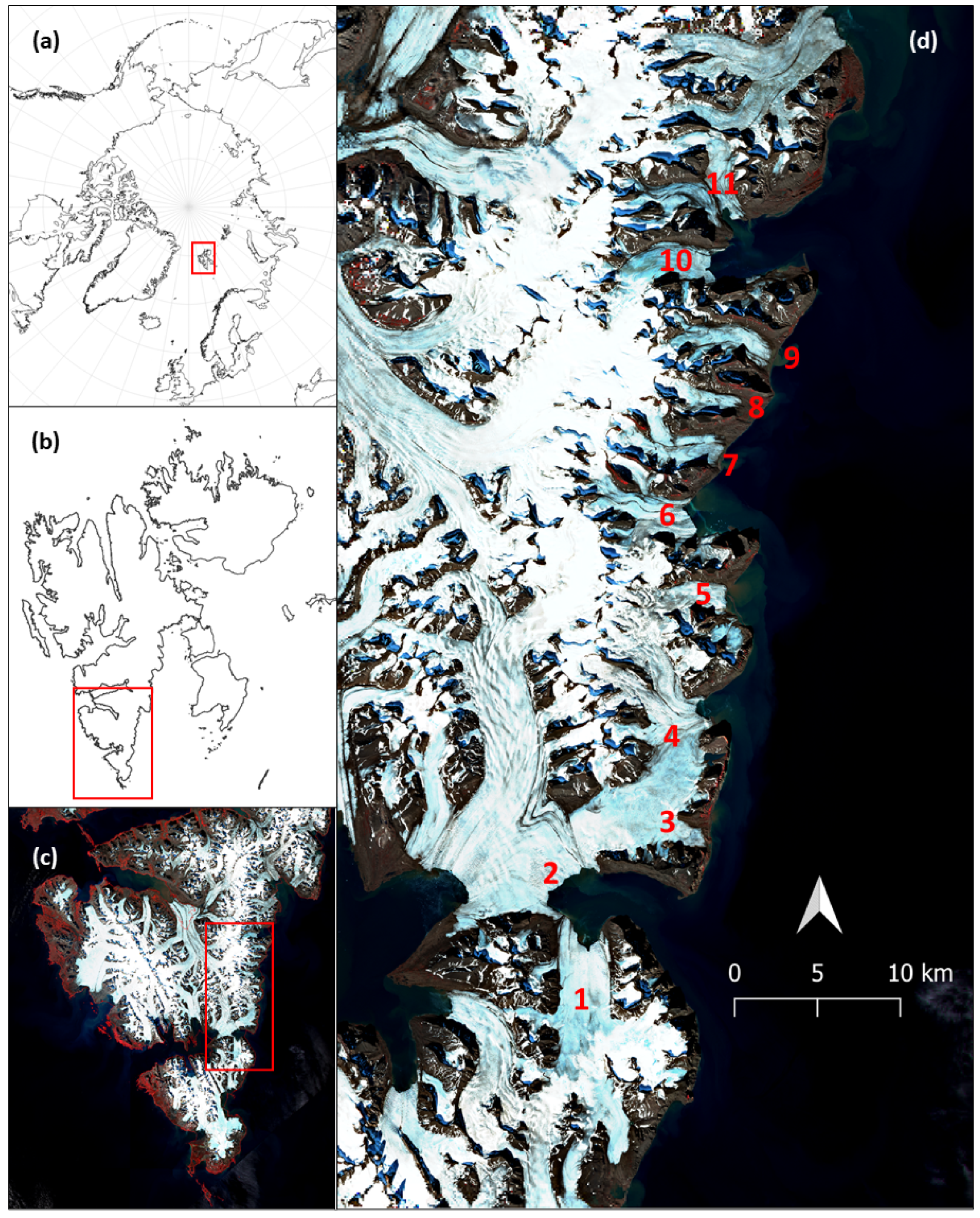
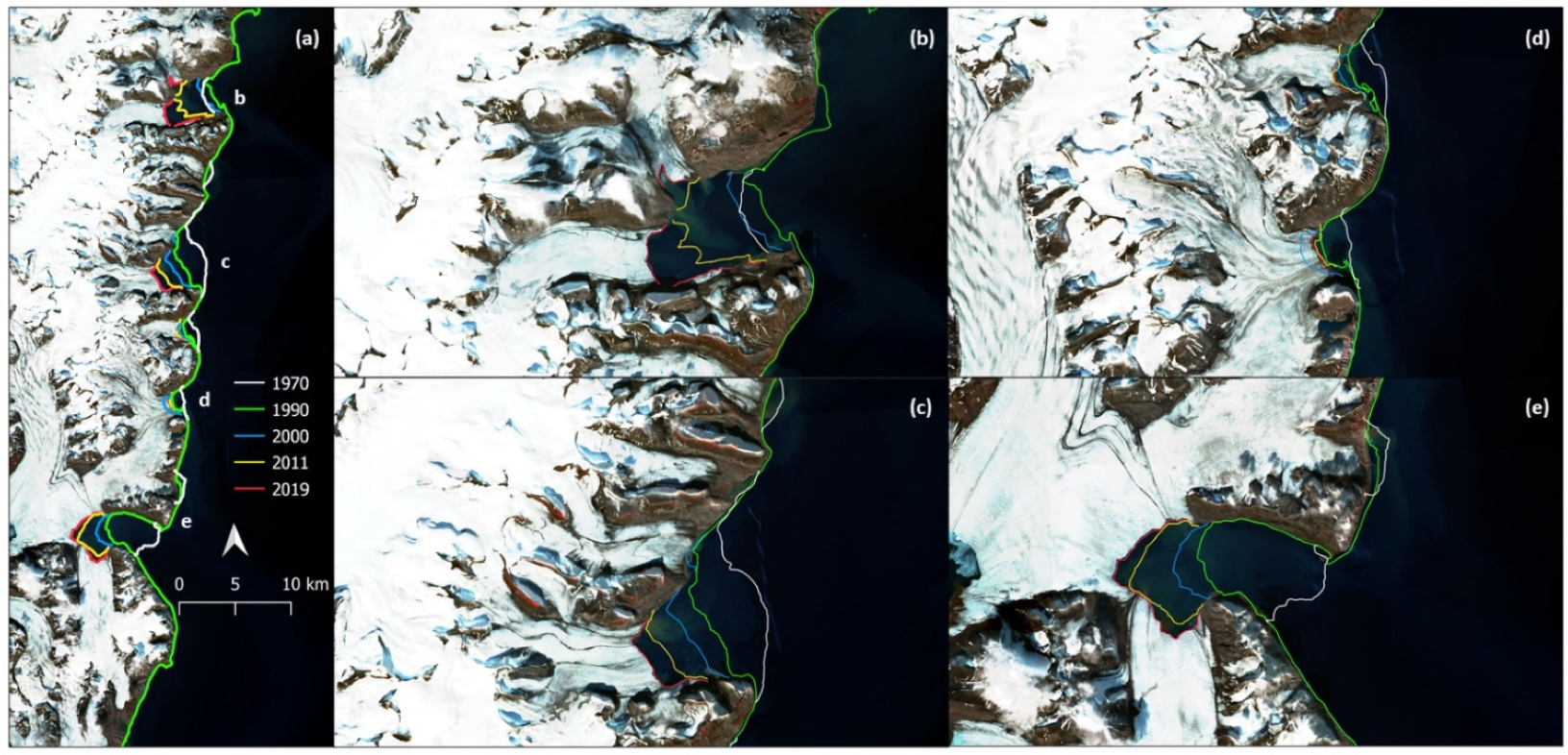
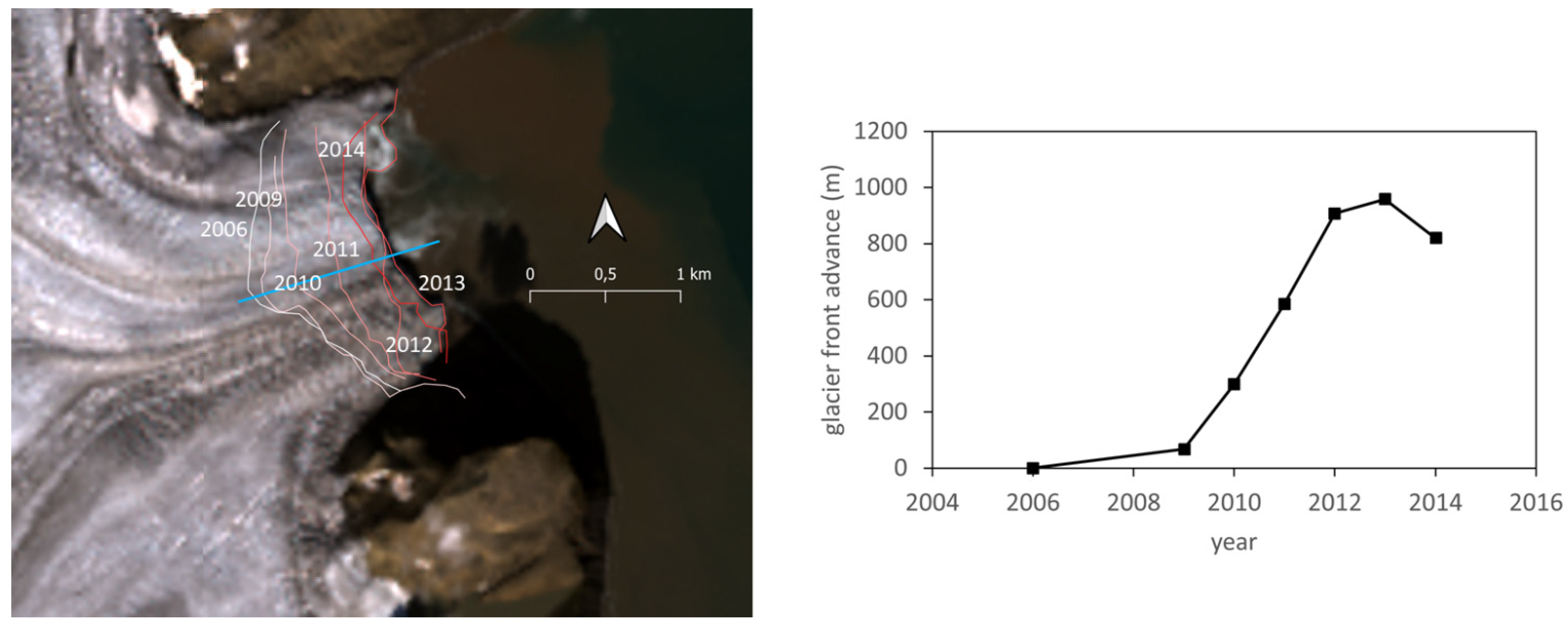
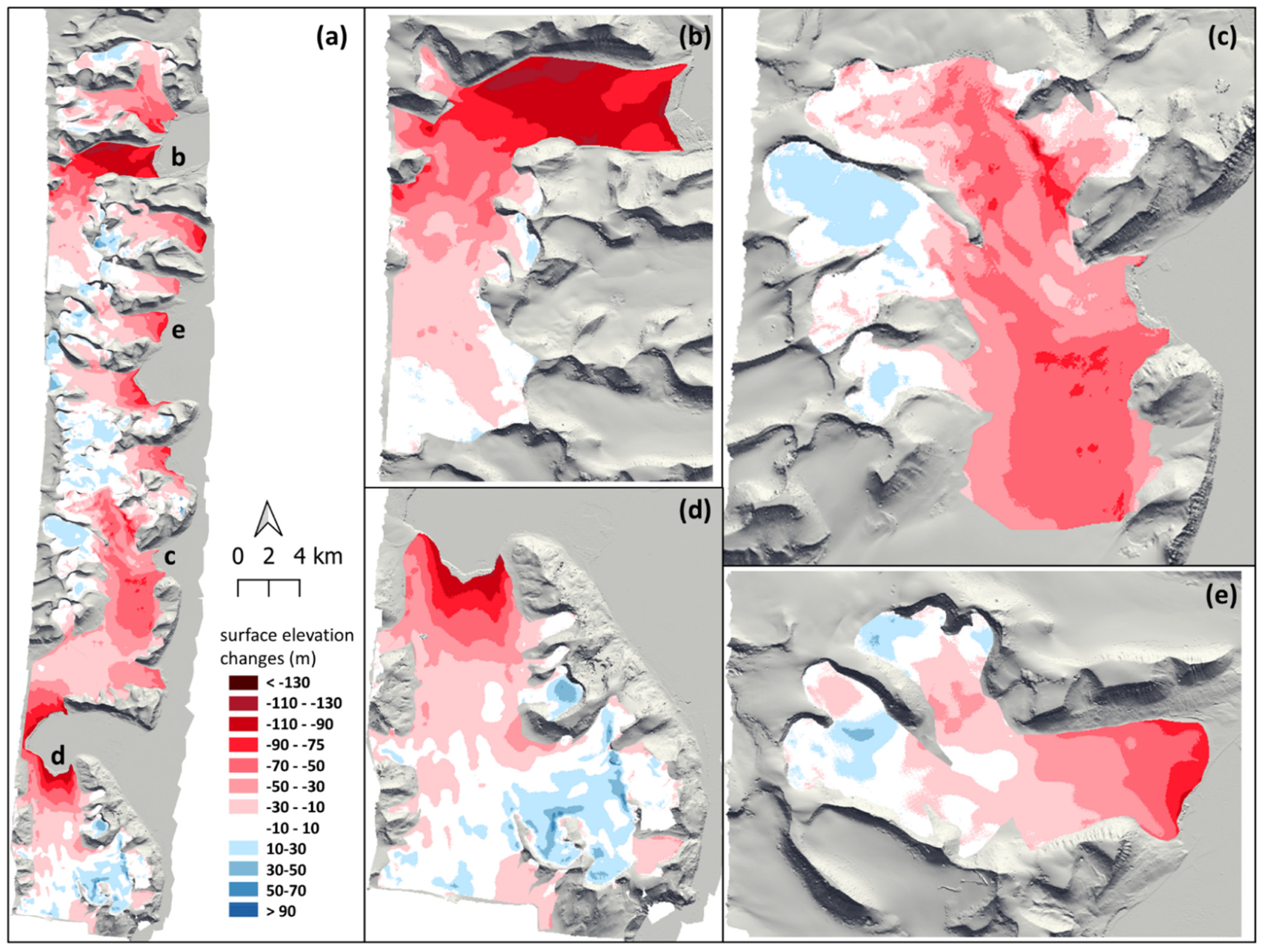
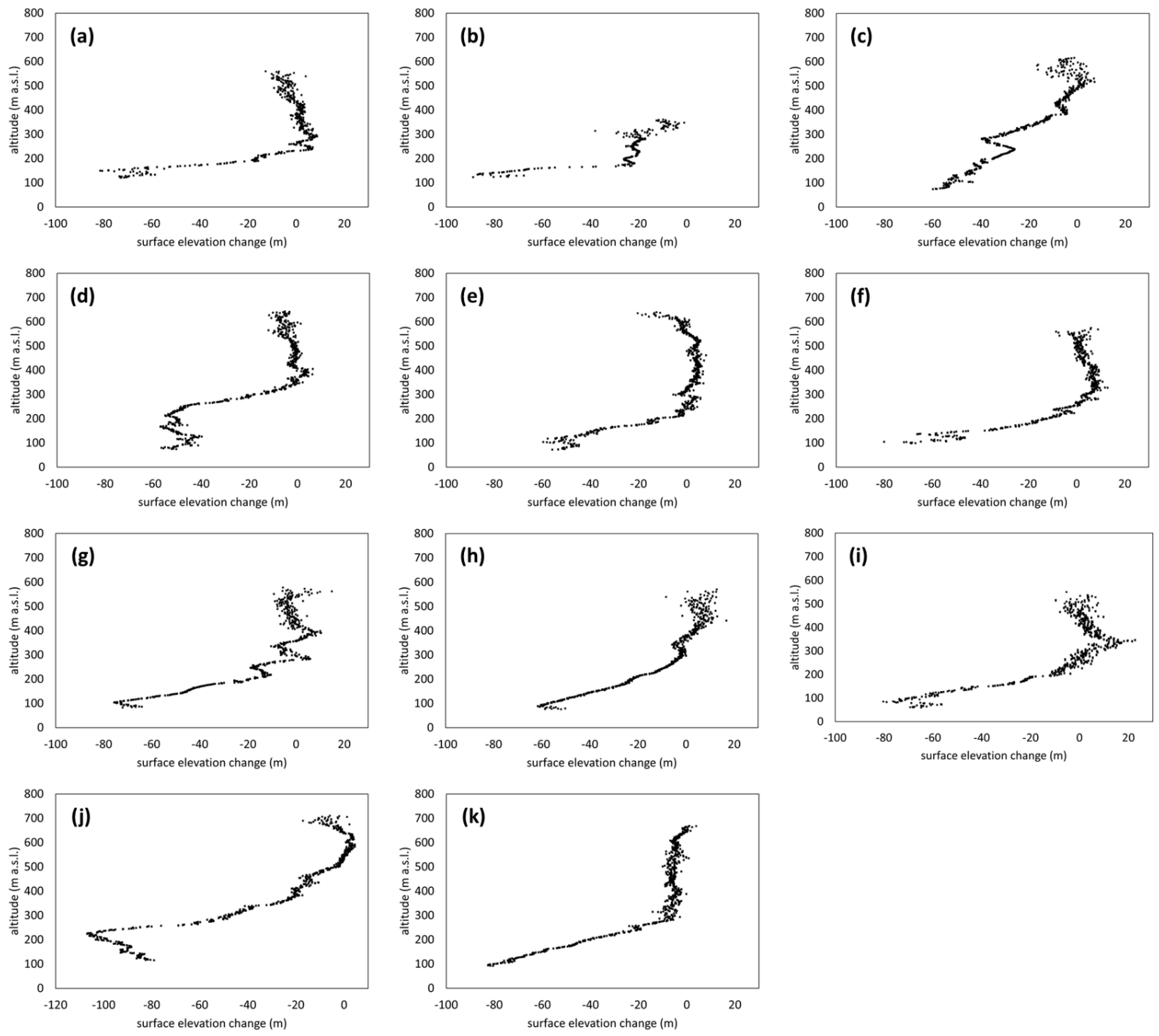
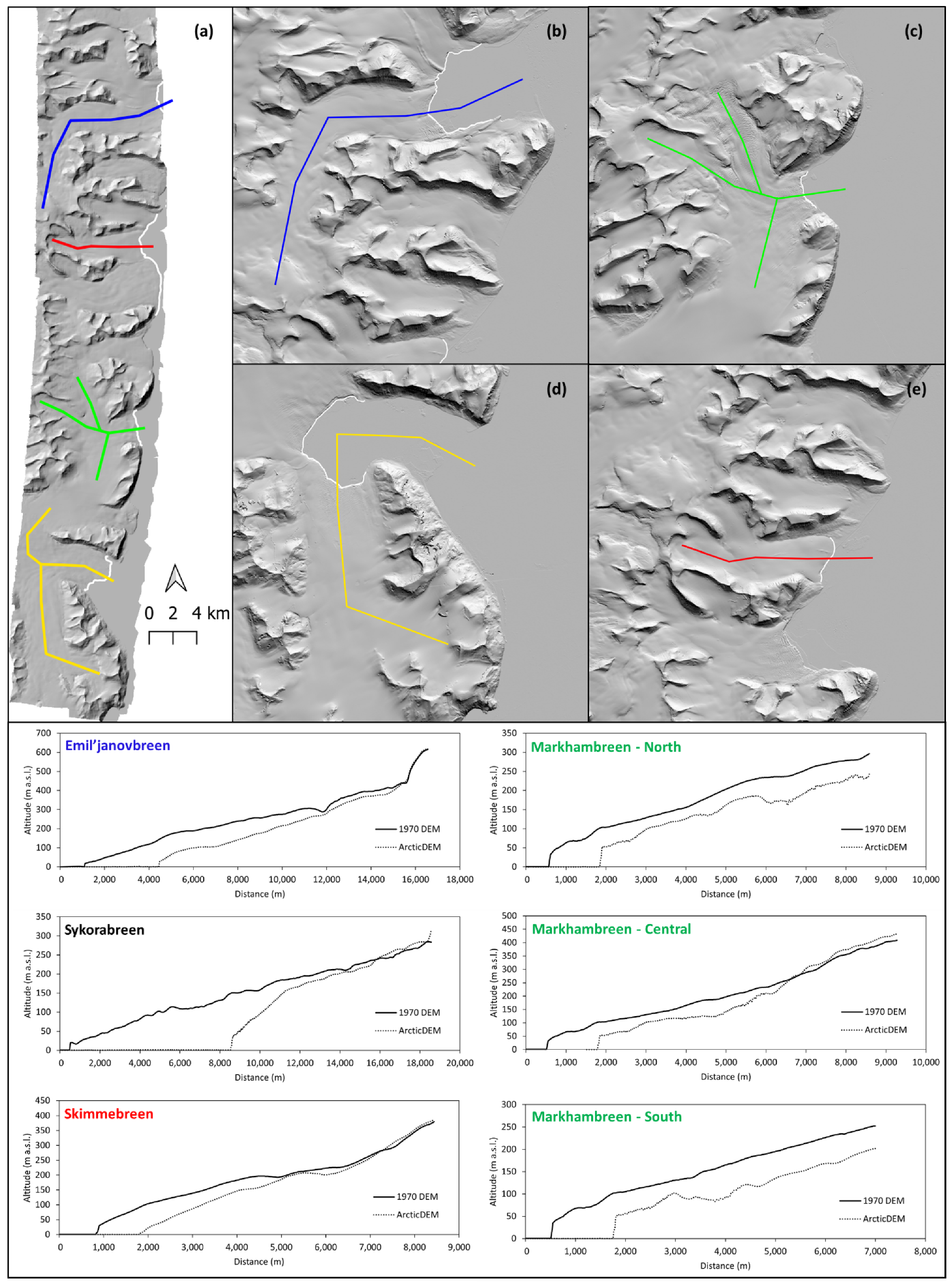
| Glacier | Id (Figure 1) | Area (km2) | Length (km) | Mean Elevation (m) | Maximum Elevation (m) | Present Terminus |
|---|---|---|---|---|---|---|
| Sykorabreen | 1 | 54.6 | 16.7 | 248 | 550 | Marine |
| Hambergbreen | 2 | 16.6 | 13.2 | 189 | 360 | Marine |
| Staupbreen | 3 | 20.2 | 7.7 | 257 | 610 | Land |
| Markhambreen | 4 | 44 | 9.2 | 278 | 640 | Marine |
| Crollbreen | 5 | 20.4 | 8.8 | 279 | 630 | Marine |
| Davisbreen | 6 | 31.2 | 12.1 | 252 | 570 | Marine |
| Skimmebreen | 7 | 14.6 | 8.1 | 261 | 580 | Land |
| Bellingbreen | 8 | 6.7 | 6.6 | 266 | 570 | Land |
| Anna Margrethbreen | 9 | 14 | 8.4 | 208 | 550 | Land |
| Emil’janovbreen | 10 | 33.7 | 16.4 | 352 | 710 | Marine |
| Spaelbreen | 11 | 26.9 | 9.9 | 291 | 670 | Marine |
| Glacier | Id (Figure 1) | Average Surface Elevation Change (m) | Annual Change (m/year) | Ice Front Retreat Rate (m/year) |
|---|---|---|---|---|
| Sykorabreen * | 1 | −12.7 | −0.27 | 149.0 149.0 |
| Hambergbreen * | 2 | −39.2 | −0.83 | |
| Staupbreen | 3 | −29.9 | −0.64 | 16.3 |
| Markhambreen | 4 | −30.5 | −0.65 | 24.5 |
| Crollbreen | 5 | −10.7 | −0.23 | 32.7 |
| Davisbreen | 6 | −11 | −0.23 | 89.8 |
| Skimmebreen | 7 | −19.5 | −0.41 | 21.4 |
| Bellingbreen | 8 | −13.8 | −0.29 | 20.4 |
| Anna Margrethbreen | 9 | −23.8 | −0.51 | 10.2 |
| Emil’janovbreen * | 10 | −45.2 | −0.96 | 71.4 71.4 |
| Spaelbreen * | 11 | −24.1 | −0.51 |
| Glacier | Id (Figure 1) | ZSECA (m a.s.l.) | Glacier above ZSECA (%) | Comment |
|---|---|---|---|---|
| Sykorabreen | 1 | 230 | 46.8 (42.2–49.7) | |
| Hambergbreen | 2 | No | 0 | The whole glacier is losing mass |
| Staupbreen | 3 | 480 | 1.2 (0.8–1.3) | |
| Markhambreen | 4 | 350 | 8.5 (6.6–15.3) | Southern part only, northern losing mass |
| Crollbreen | 5 | 240 | 45.4 (39.7–50.6) | |
| Davisbreen | 6 | 250 | 45.7 (42.1–47.6) | |
| Skimmebreen | 7 | 300–400 | 18.6 (15.9–21.2) | Different altitude on different glacier branches |
| Bellingbreen | 8 | 370 | 17.7 (16.2–21.9) | |
| Anna Margrethbreen | 9 | 250 | 23.9 (21.8–25.9) | |
| Emil’janovbreen | 10 | 530 | 9 (7.3–11.2) | Southern part only |
| Spaelbreen | 11 | No | 0.2 (0–0.6) | Small discontinuous areas of mass gain |
Publisher’s Note: MDPI stays neutral with regard to jurisdictional claims in published maps and institutional affiliations. |
© 2022 by the authors. Licensee MDPI, Basel, Switzerland. This article is an open access article distributed under the terms and conditions of the Creative Commons Attribution (CC BY) license (https://creativecommons.org/licenses/by/4.0/).
Share and Cite
Kavan, J.; Tallentire, G.D.; Demidionov, M.; Dudek, J.; Strzelecki, M.C. Fifty Years of Tidewater Glacier Surface Elevation and Retreat Dynamics along the South-East Coast of Spitsbergen (Svalbard Archipelago). Remote Sens. 2022, 14, 354. https://doi.org/10.3390/rs14020354
Kavan J, Tallentire GD, Demidionov M, Dudek J, Strzelecki MC. Fifty Years of Tidewater Glacier Surface Elevation and Retreat Dynamics along the South-East Coast of Spitsbergen (Svalbard Archipelago). Remote Sensing. 2022; 14(2):354. https://doi.org/10.3390/rs14020354
Chicago/Turabian StyleKavan, Jan, Guy D. Tallentire, Mihail Demidionov, Justyna Dudek, and Mateusz C. Strzelecki. 2022. "Fifty Years of Tidewater Glacier Surface Elevation and Retreat Dynamics along the South-East Coast of Spitsbergen (Svalbard Archipelago)" Remote Sensing 14, no. 2: 354. https://doi.org/10.3390/rs14020354
APA StyleKavan, J., Tallentire, G. D., Demidionov, M., Dudek, J., & Strzelecki, M. C. (2022). Fifty Years of Tidewater Glacier Surface Elevation and Retreat Dynamics along the South-East Coast of Spitsbergen (Svalbard Archipelago). Remote Sensing, 14(2), 354. https://doi.org/10.3390/rs14020354







